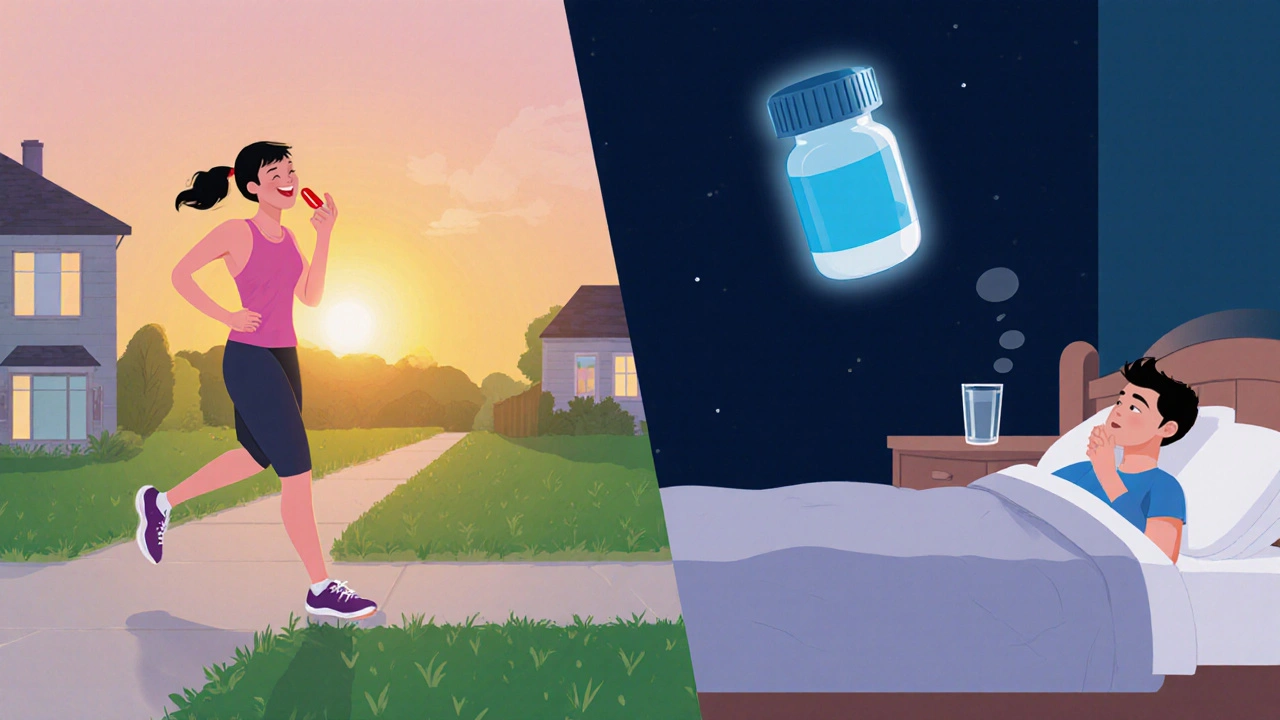Acid Reflux Medication Selector
Select Your Symptom Pattern
Recommended Medication:
Quick Overview
- Zantac (ranitidine) is an H2‑blocker that was pulled from many markets after NDMA contamination concerns.
- Modern alternatives include famotidine (another H2‑blocker), proton‑pump inhibitors like omeprazole and esomeprazole, and over‑the‑counter antacids.
- Choice depends on speed of relief, duration of action, safety profile, and whether you need prescription strength.
- For occasional heartburn, antacids work fast; for chronic GERD, PPIs or H2‑blockers are preferred.
- Always check with a healthcare professional before switching, especially if you have liver or kidney issues.
When it comes to treating heartburn, Zantac is a brand name for the drug ranitidine, an H2‑blocker that reduces stomach acid production. It was a go‑to over‑the‑counter option for decades, but a wave of safety alerts reshaped the market. Below we compare Zantac with the most common alternatives you’ll find on pharmacy shelves or via prescription, so you can pick the right tool for your symptoms.
What Is Zantac (Ranitidine) and How Does It Work?
Ranitidine is an H2‑receptor antagonist. By blocking histamine receptors in the stomach lining, it lowers the amount of acid released after meals. Typical dosing for adults is 150mg twice daily or 300mg once daily, and effects start within an hour, lasting up to 12hours.
Because it targets a specific step in acid production, ranitidine often provides enough relief for mild to moderate heartburn without the stronger, longer‑lasting impact of proton‑pump inhibitors (PPIs).
Safety Scare: Why Zantac Was Withdrawn
The turning point came in 2019 when the U.S. Food and Drug Administration (FDA) detected N‑nitrosodimethylamine (NDMA) in several batches of ranitidine. NDMA is a probable human carcinogen, and long‑term exposure can increase cancer risk. After extensive testing, the agency asked manufacturers to pull the product from shelves worldwide.
Most countries now require ranitidine to be reformulated or discontinued. The recall left many patients wondering what to use instead, which brings us to the alternatives.

Major Alternatives Overview
Acid‑reducing medications fall into three broad categories:
- H2‑blockers - famotidine, cimetidine, nizatidine.
- Proton‑pump inhibitors (PPIs) - omeprazole, esomeprazole, pantoprazole.
- Antacids - calcium carbonate, magnesium hydroxide, alum‑gel.
Each class has a distinct speed‑of‑onset, duration, and safety profile. Below we focus on the most popular stand‑ins for Zantac.
Detailed Comparison of Zantac and Its Top Alternatives
| Medication | Drug Class | Typical OTC Dose | Onset of Relief | Duration of Effect | Pros | Cons / Safety Notes |
|---|---|---|---|---|---|---|
| Zantac (Ranitidine) | H2‑blocker | 150mg BID or 300mg QD | 30-60min | Up to 12hr | Effective for mild‑moderate heartburn; cheap; low drug‑interaction risk. | NDMA contamination led to market withdrawal; not available in many regions. |
| Pepcid (Famotidine) | H2‑blocker | 20mg BID (OTC) or 40mg BID (prescription) | 30-60min | Up to 12hr | No NDMA concerns; works for night‑time reflux; lower cost than many PPIs. | May be less potent than PPIs for severe GERD; rare kidney issues at high doses. |
| Prilosec (Omeprazole) | Proton‑pump inhibitor | 20mg daily (OTC) or 40mg BID (prescription) | 1-4hr | 24hr+ | Very strong acid suppression; ideal for erosive esophagitis and Barrett’s. | Long‑term use linked to B12 deficiency, magnesium loss, and infection risk. |
| Nexium (Esomeprazole) | Proton‑pump inhibitor | 20mg daily (OTC) or 40mg daily (prescription) | 1-4hr | 24hr+ | Same class as omeprazole but with slightly better bioavailability; often recommended after failed H2‑blocker therapy. | Same long‑term risks as other PPIs; higher price point. |
| Calcium Carbonate Antacids | Antacid | 500‑1000mg as needed (chewable tablets) | 5-10min | 2‑3hr | Instant relief; also supplies calcium. | Can cause rebound acid production; not suitable for chronic GERD; may interfere with other meds. |
How to Choose the Right Option for You
Think of the decision as matching three variables: symptom severity, how quickly you need relief, and how long you plan to stay on the medication.
- Occasional heartburn (once‑or‑twice a week): Antacids give instant, short‑term relief without lingering effects.
- Frequent mild‑to‑moderate reflux (several times a week): A daily H2‑blocker like famotidine is a balanced choice-fast enough, low cost, and safe for long‑term use.
- Severe or erosive GERD diagnosed by a doctor: PPIs such as omeprazole or esomeprazole are the most effective, but you’ll likely need a short‑term trial and regular monitoring.
Other factors to weigh:
- Kidney or liver function: H2‑blockers are cleared renally; dose‑adjust if creatinine clearance is low.
- Drug interactions: PPIs can affect clopidogrel activation; famotidine has fewer interactions.
- Cost and insurance coverage: Generic famotidine and omeprazole are usually covered; brand‑only PPIs can be pricey.
Practical Tips & Safety Considerations
Regardless of which medication you choose, keep these habits in mind:
- Take H2‑blockers 30minutes before meals for optimal effect.
- Never double‑dose antacids to speed relief-this can raise calcium levels dangerously.
- If you need a PPI for more than eight weeks, ask your doctor about vitamin B12 and magnesium testing.
- Watch for side‑effects like headache, dizziness, or constipation; report persistent issues.
- Store all meds in a cool, dry place; discard any that look discolored or are past expiration.
For people with gastro‑esophageal reflux disease (GERD), lifestyle tweaks-elevating the head of the bed, avoiding late‑night meals, and reducing caffeine-often enhance drug efficacy.

Frequently Asked Questions
Can I safely switch from Zantac to famotidine?
Yes. Famotidine works the same way as ranitidine but without the NDMA risk. Start with the OTC dose (20mg twice daily) and see how you feel. If symptoms persist, talk to a pharmacist about a prescription strength.
Are PPIs stronger than H2‑blockers?
Generally, yes. PPIs block the final step of acid production, achieving up to 90% suppression, while H2‑blockers lower acid by about 50‑60%. That’s why PPIs are preferred for severe esophagitis, but H2‑blockers are often enough for milder reflux.
Do antacids interfere with other medications?
They can. Calcium carbonate can bind to antibiotics like tetracycline and reduce their absorption. If you’re on multiple drugs, space antacid use at least two hours apart.
How long is it safe to take famotidine daily?
Most adults can use the low‑dose OTC version indefinitely, provided kidney function is monitored. High prescription doses (40mg twice daily) should be limited to 12‑weeks unless a doctor advises otherwise.
What should I do if I experience new chest pain while on a heart‑burn medication?
Stop the medication and seek medical attention immediately. Chest pain could signal heart issues or a serious esophageal complication that needs urgent evaluation.
In short, the era of Zantac may be over, but plenty of safe, effective options remain. By matching the drug class to your symptom pattern and health profile, you can keep reflux under control without unnecessary risk.

